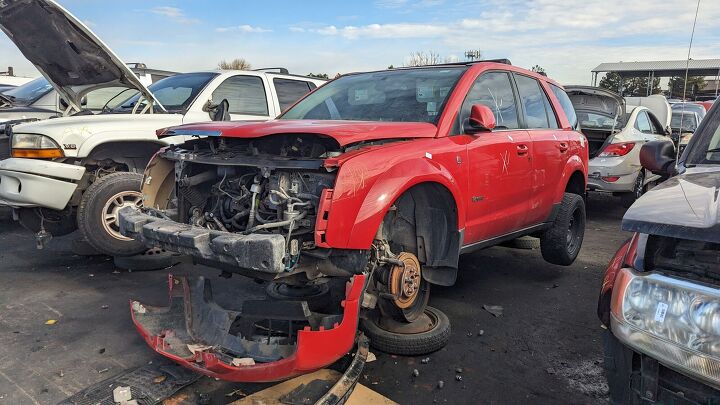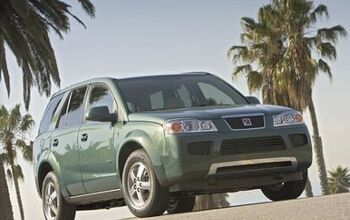Junkyard Find: 2007 Saturn Vue Green Line

Honda beat everybody to the production gasoline-electric hybrid game in the United States, putting the Insight in showrooms in 1999. Toyota followed with the Prius a year later, but it took GM until 2006 to introduce its first true gasoline-electric hybrid here. That car was the 2007 Saturn Vue Green Line, and I managed to find one in a Denver-area car graveyard recently.
Our nameless reviewer felt, back in 2006, that the Vue's panel gaps made it the "automotive equivalent of a shotgun shack" and calculated that the Green Line version would require 90,000 miles of driving with $2.15/gallon gas in order to recoup its cost over the pure-gazzoline version. In fact, fuel prices went insane right around the time that review was written.
If we look at the fine print, GM actually introduced a sort-of-a-hybrid vehicle as a 2004 model, though the 2004 Chevrolet Silverado Hybrid/GMC Sierra Hybrid didn't have regenerative braking.
Ford launched the Escape Hybrid as a 2005 model (its Mercury Mariner and Mazda Tribute siblings showed up a bit later), so The General had some catching up to do in the green-car department. Nissan introduced the Altima Hybrid as a 2007 model (and using licensed Toyota hardware), though it disappeared quickly and without leaving much trace.
Toyota and Honda didn't have much to fear from the Vue Green Line's hybrid technology, but it did benefit from regenerative braking and delivered a pretty good 23 city/29 highway miles per gallon (versus 19/25 mpg for the base Vue with 2.2-liter engine and automatic).
The system replaced the starter motor and alternator with a belt-driven motor/generator rig that generated five horsepower and 48 pound-feet. A 2.4-liter Ecotec gas-burner did most of the work with its 170 horsepower.
You could get a manual transmission in the regular Vue, but the Green Line was slushbox-only.
The green paint has faded from this Green Line badge, but it was supposed to be the Gaia-loving counterpart to the planet-ravaging Saturn Ion Red Line. I have mounted Red Line and Green Line badges side-by-side on my garage wall, in order to represent the duality of man.
The storm clouds over General Motors were getting darker by the minute when this car was built, and Saturn would soon have its head on the chopping block. Geo and Oldsmobile were already gone, with Pontiac and Saturn following in 2010.
The entry-level '07 Vue started at $17,995 (about $27,588 in 2024 dollars), while the Green Line version had an MSRP of $22,995 ($35,254 after inflation). Even with $4/gallon gas ($6.13 gallon in today's money), it would have taken quite a while to break even with the Green Line.
The Vue's platform outlived Saturn and still lives today, though. You'll find its derivatives underpinning everything from the Suzuki XL7 to the Wuling Almaz, and it all began with the 2002 Vue.
The interior isn't bad, but a 17-year-old non-AWD car made by a long-defunct brand doesn't command much resale value these days.
There is a way to recapture the world's imagination. To stay the same in one way, and evolve in another. Chapter 11 bankruptcy was approaching quickly, by the way.
A 2007 Saturn Vue Green Line hybrid in a Colorado wrecking yard.
A 2007 Saturn Vue Green Line hybrid in a Colorado wrecking yard.
A 2007 Saturn Vue Green Line hybrid in a Colorado wrecking yard.
A 2007 Saturn Vue Green Line hybrid in a Colorado wrecking yard.
A 2007 Saturn Vue Green Line hybrid in a Colorado wrecking yard.
A 2007 Saturn Vue Green Line hybrid in a Colorado wrecking yard.
A 2007 Saturn Vue Green Line hybrid in a Colorado wrecking yard.
A 2007 Saturn Vue Green Line hybrid in a Colorado wrecking yard.
A 2007 Saturn Vue Green Line hybrid in a Colorado wrecking yard.
[Images: The Author]
Become a TTAC insider. Get the latest news, features, TTAC takes, and everything else that gets to the truth about cars first by subscribing to our newsletter.

Murilee Martin is the pen name of Phil Greden, a writer who has lived in Minnesota, California, Georgia and (now) Colorado. He has toiled at copywriting, technical writing, junkmail writing, fiction writing and now automotive writing. He has owned many terrible vehicles and some good ones. He spends a great deal of time in self-service junkyards. These days, he writes for publications including Autoweek, Autoblog, Hagerty, The Truth About Cars and Capital One.
More by Murilee Martin
Latest Car Reviews
Read moreLatest Product Reviews
Read moreRecent Comments
- SCE to AUX Red flags everywhere on this one. The mods are a negative, and what good is upgraded suspension that hasn't moved in 15 years?This car needs a total overhaul, and $18k for a basketcase is a bad starting point.
- Theflyersfan Yet another seller grossly overvaluing what could/will likely become a project car because with those aftermarket mods, it's anyone's guess how it's holding up now. Even the two comments in the listing are letting the seller know that he's asking too much. And that's a shame because this is one desirable Japan bubble-era car to snag. But if it can't pass California smog, it likely won't pass emissions in states that are close or meets their inspection limits so that knocks out a big chunk of the west and east coasts. So, bring a truck and a trailer and be prepared to haul it a distance. These sellers need to be real. Aftermarket turbos aren't going to help reliability in the long run. Expect a total engine inspection/rebuild as part of this project. New body work and paint. Replace everything that is rubber from tires to belts to hoses. Professional cleaning of interior and possibly new upholstery depending on the damage done by 15 years of sitting and rotting. Given the work and transportation/towing involved, even $10,000 might be too high. Someone will want this, that's for sure, but the seller needs to adjust expectations a bit.
- Bd2 These vehicles, especially when compared to Hyundai models of the same time were total junk even when new.
- Theflyersfan I'll leave a note under this guy's windshield letting them know that they need to park their car until it can get fixed. I'm sure he'll understand.
- SCE to AUX [list=1][*]CfC: The fuel economy of a Sentra is so high that the required gain (25%, I think) to make the vehicle qualify meant that there were few cars that could beat it. Besides, a Sentra owner is unlikely to be in a position to take on a new car payment. Despite the cash, you still had to buy the new car.[/*][*]Takata recall: So 11% of these vehicles remain untouched. Some people think recalls are for chumps, because they know their car better than anybody, and because the dealer is going to try to rip them off somehow.[/*][/list=1]Honda had the same problem trying to contact owners. I think we've reached the point where due diligence has been exercised.





















































Comments
Join the conversation
I'll say one thing about those plastic bodies: they still look good after a decade and a half. Automakers should be sheathing their cars in petroleum-based plastic before they thin out the "sheet metal" to foil thickness.
There’s one of these around the corner from me. It still runs…driven daily, in fact. That fact always surprises me.